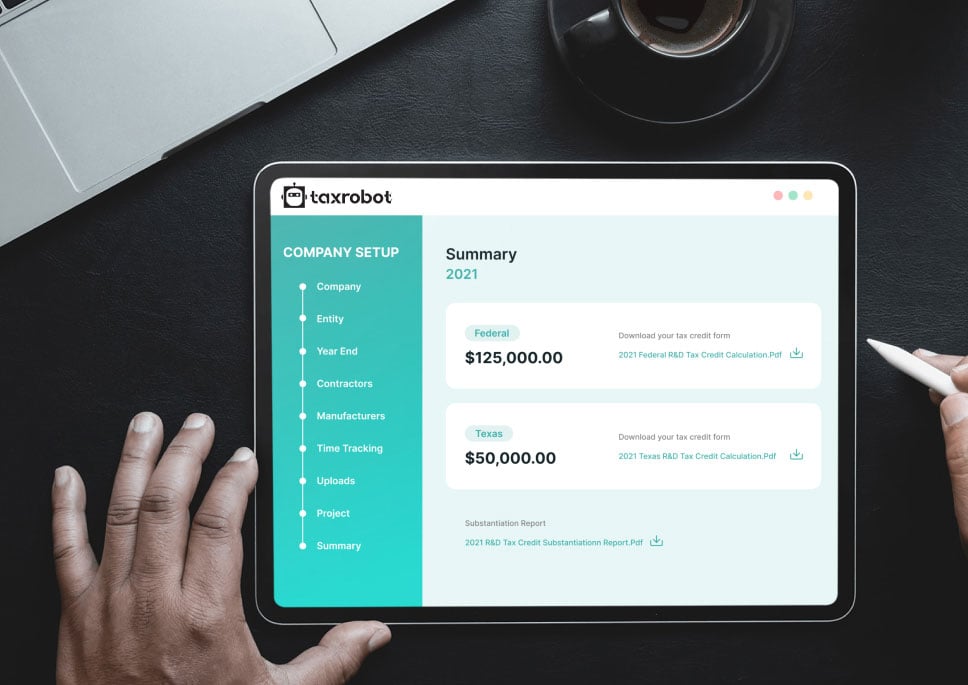Texas R&D Credit
Get started with TaxTobot to maximize your business’s R&D tax credit.
Maximize your State Credits today!
Put the R&D tax credit process on autopilot.
Trusted By:








Texas R&D Credit
Discover your eligibility for Texas R&D tax credits and supercharge your enterprise.
Does Texas Have an R&D Tax Credit?
Research and Development Credits are tax incentives given to businesses as a way to encourage them to continue developing and thriving. Texas offers these credits to build up businesses in the state. These are designed for both large and small businesses.
In Texas, these R&D credits can be used in two different ways. They can be used as a franchise tax credit or as a sales and use tax exemption on certain purchases. Note that you cannot apply for both the franchise tax credit and the sales and use tax exemption certificate during the same tax period.
Franchise Tax Credit
R&D tax credits applied in this way are applied to the following year’s taxes. So any expenses incurred in 2023 will be credited on the 2024 franchise tax filing. The amount of this credit will be 5% or 6.5% of the difference between:
- Qualified expenses that are incurred in Texas during the reporting period; and
- 50% of the average qualified research expenses incurred in Texas (QRETs) during the three tax years immediately preceding the reporting year.
You can claim this credit via the Long Form Franchise Tax Report. You’ll also need to include a Research and Development Activities Credits Schedule and a Credits Summary Schedule. All of these forms can be submitted through the Texas Comptroller’s portal.
Sales and Use Tax Exemption
Alternatively, you can choose to use your R&D credit towards your sales and use tax. These credits are calculated the same way as for the franchise tax credit.
However, you’ll need to apply for it differently. First, apply for a registration number. Then you can complete the Texas Qualified Research Sales and Use Tax Exemption Certificate from the Texas comptroller. This will allow you to have a certificate to present when you purchase qualifying items. In addition, you’ll need to register with the Comptroller’s office.
It is important to note that retailers are not required to accept the sales tax exemption certificate.
Recent Changes to the Credit
A recent change allows each member of a combined group to carry their own credits forward individually.
In addition, the definition of Internal-use software (IUS) has reverted to its pre-2016 federal version in another recent change. This could affect pilot prototypes and models as it makes the requirements more strict.
Staying up-to-date on changes like these can be difficult. To make it easier, consider using R&D tax credit software. With this, you won’t need to wonder if you are eligible or not constantly. We’ll use the information you provide to ensure you get the maximum credit. Plus, we’ll handle everything if you are audited.
Is Your Business Eligible?
Many types of businesses are eligible as long as they meet the requirements. Sole proprietors are not eligible.
The franchise tax form is due on May 15. If you have an extended deadline, it’s due on November 15. In addition, you must file an Annual Information Report by March 31 of each calendar year that you claim the sales tax exemption.
Four-Part Test
As for the federal R&D tax credit, your research activities must pass the four-part test to qualify. This means they must:
- Be technological in nature
- Be for a permitted purpose
- Eliminate technical uncertainty
- Follow a process of experimentation
How Much Could You Save?
The base amount is half of the average of the QRETS from the three previous taxable years.
- In general:
The tax credit for Texas is 5% of the excess amount of your QRETs over the base amount for the current period.
If you don’t have qualifying expenses in at least one of the three years, the credit will be 2.5% of all QREs incurred during the current year.
- If your company contracts with universities or colleges to perform R&D activities:
The credit is 6.25% of the excess over the base amount.
If there are no QRETs in the preceding three years, the credit is 3.125% of all QREs in the current period.
- You can only offset 50% of the franchise tax credit due in a single period. However, you can carry the credit forward for up to 20 years.
Wondering How Much You’re Missing Out On?
Curious to know how much you could be saving with the R&D tax credit? Find out with our credit calculator.
Take a sneak peak

- Limited Time Offer
- Simple Onboarding
- Easy to Use
R&D Tax Credits FAQs
The four-part test as outlined in the Internal Revenue Code is used to determine qualified R&D activity.
The Four-Part Test
1). New Or Improved Business Component
Creation of a new product, process, formula, invention, software, or technique; or improving the performance, functionality, quality, or reliability of existing business component.
- Construction of new buildings or renovation of existing buildings
- Invention of a software application
- Manufacturing of a new product or the improvement of the production process for an existing product
- Creation of design documentation
2). Technological In Nature
The activity fundamentally relies on principles of the physical or biological sciences, engineering, or computer science. A taxpayer does not need to obtain information that exceeds, expands or refines the common knowledge of skilled professionals in a particular field.
- Physics (relationship between mass, density and volume; loading as the
result of gravitational attraction) - Engineering (mechanical, electrical, civil, chemical)
- Computer science (theory of computation and design of computational systems)
3). Elimination Of Uncertainty
Uncertainty exists if the information available to the taxpayer does not establish the capability or method for developing or improving the business component, or the appropriate design of the business component.
- The capability of a manufacturer to create a part within the specified tolerances
- The appropriate method of overcoming unsuitable soil conditions during construction
- The appropriate software design to meet quality and volatility requirements
4). Process Of Experimentation
A process designed to evaluate one or more alternatives to achieve a result where the capability or method of achieving that result, or the appropriate design of that result, is uncertain as of the beginning of the taxpayer’s research activities.
- Systematic process of trial and error
- Evaluating alternative means and methods
- Computer modeling or simulation Prototyping Testing
The R&D tax credit is one of the most misunderstood tax incentives available. Considering the myriad of industries and activities that legally qualify for the credit, the term “research and development” is a misnomer. Additionally, the R&D tax credit requires specialized knowledge and technology to identify and calculate the incentive properly.
Companies of various industries are unaware that they are eligible to claim the R&D tax credit. Under the Internal Revenue Code’s definition of R&D, many common activities qualify. You can get tax benefits for industries including software, technology, architecture, engineering, construction, manufacturing, and more.
The R&D tax credit can be claimed for all open tax years. Generally, open tax years include the prior three tax years due to the statute of limitations period. In certain circumstances, the law allows businesses to claim the R&D tax credit for an extended period of time. It is common for companies to amend previous tax years to claim this benefit and reduce the maximum amount of tax liability.
Partnerships and S corporations must file this form to claim the credit. The credit will flow from the Form 6765, to the Schedule K-1, to the Form 3800 on the individual’s tax return. For individuals receiving this credit that have ownership interest in a partnership or S corporation, Form 6765 is not required on the individual return.
Individuals claiming this credit can report the credit directly on Form 3800, General Business Credit if their only source for the credit is a partnership, S corporation, estate, or trust. Otherwise, Form 6765 must be filed with the individual’s tax return (e.g. sole proprietorship).
For tax years prior to 2016, the credit can be used to reduce the taxpayer’s regular tax liability down to the tentative minimum tax. The credit cannot be used to offset alternative minimum tax. Beginning in tax year 2016, eligible small businesses have expanded utilization for the credit. For these eligible small businesses, the regular tax liability can offset alternative minimum tax using the “25/25” rule.
What our customers have to say
I highly recommend TaxRobot to anyone considering an R&D Tax Credit software to complete their analysis.

We decided to switch to TaxRobot… Best decision we’ve ever made. More affordable, and less complicated.

I couldn’t believe how easy it was! In under an hour, we saved enough money to hire a new employee.
